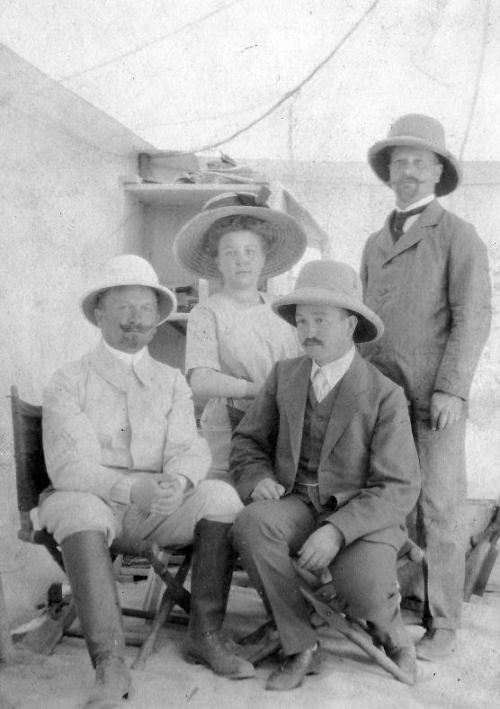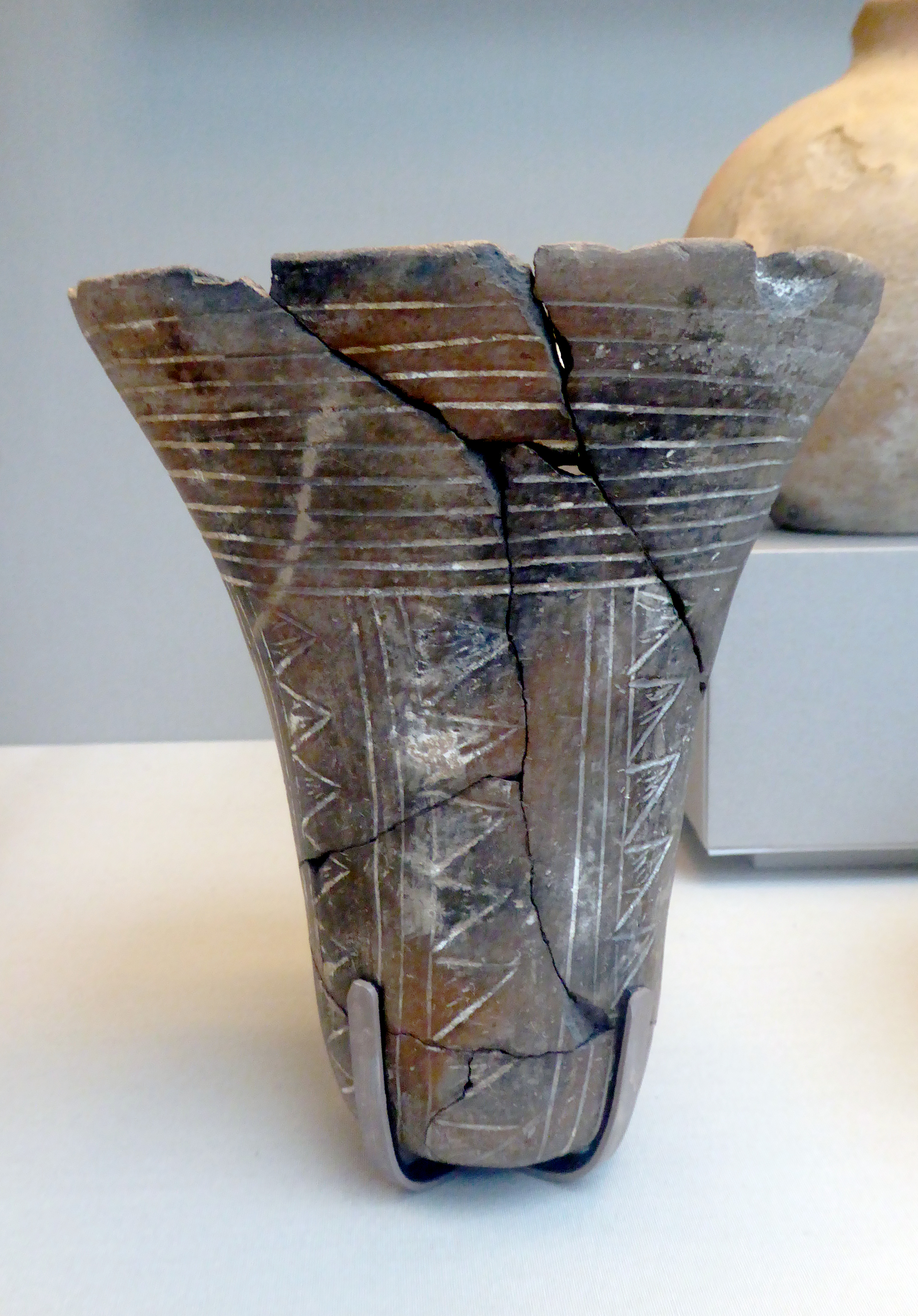|
Merimde
The Merimde culture (also Merimde Beni-Salame or Benisalam) ( ar, مرمدة بني سلامة) was a Neolithic culture in the West Nile Delta in Lower Egypt, which corresponds in its later phase to the Faiyum A culture and the Badari culture in Predynastic Egypt. It is estimated that the culture evolved between 4800 and 4300 BC. Merimde also refers to the archaeological site of the same name. Archaeological work The culture was concentrated around Merimde Beni Salama, the main settlement site, located in the West delta of the Nile in Lower Egypt 45 km northwest of Cairo. The site was discovered by German archaeologist Hermann Junker, who excavated 6,400 m2 of the site during his West Nile Delta expedition in 1928. Early on, the settlement had been considered to be ca. 25 hectares, but recent research expanded this to at least 40 hectares. Later excavations in the 1970s performed by the Egyptian Antiquities Organization and the German Institute of Archaeology led to t ... [...More Info...] [...Related Items...] OR: [Wikipedia] [Google] [Baidu] |
Merimde Beni Salama
Merimde Beni Salama is a Neolithic settlement in Egypt, in the West delta of the Nile, 45 km northwest of Cairo. It is the typesite of Merimde culture. The settlement was occupied for about 800 years, from around 5000 to 4200 BC. The population may have reached as many as 16,000. The site represents the earliest evidence for a fully sedentary settlement in the Nile valley. History of research The site was discovered by Hermann Junker during his West Delta Expedition. He excavated the site from 1923 to 1939. In 1976, excavations were continued by the Egyptian Antiquities Organisation. In 1977-1982, excavations were conducted by the German Institute of Archaeology in Cairo under the direction of Josef Eiwanger. Description Lithic assemblages Merimde is located near the terraces at the Wadi el-Gamal. A wide variety of Paleolithic lithic assemblages have been discovered in the area. Finds around Merimde Beni Salama fall into four broad phases, the Lower Palaeolithic, the ... [...More Info...] [...Related Items...] OR: [Wikipedia] [Google] [Baidu] |
Faiyum A Culture
Prehistoric Egypt and Predynastic Egypt span the period from the earliest human settlement to the beginning of the Early Dynastic Period around 3100 BC, starting with the first Pharaoh, Narmer for some Egyptologists, Hor-Aha for others, with the name Menes also possibly used for one of these kings. At the end of prehistory, "Predynastic Egypt" is traditionally defined as the period from the final part of the Neolithic period beginning c. 6000 BC to the end of the Naqada III period c. 3000 BC. The dates of the Predynastic period were first defined before widespread archaeological excavation of Egypt took place, and recent finds indicating very gradual Predynastic development have led to controversy over when exactly the Predynastic period ended. Thus, various terms such as "Protodynastic Period of Egypt, Protodynastic period", "Zero Dynasty" or "Dynasty 0" are used to name the part of the period which might be characterized as Predynastic by some and Early Dynastic by others. Th ... [...More Info...] [...Related Items...] OR: [Wikipedia] [Google] [Baidu] |
Predynastic Egypt
Prehistoric Egypt and Predynastic Egypt span the period from the earliest human settlement to the beginning of the Early Dynastic Period around 3100 BC, starting with the first Pharaoh, Narmer for some Egyptologists, Hor-Aha for others, with the name Menes also possibly used for one of these kings. At the end of prehistory, "Predynastic Egypt" is traditionally defined as the period from the final part of the Neolithic period beginning c. 6000 BC to the end of the Naqada III period c. 3000 BC. The dates of the Predynastic period were first defined before widespread archaeological excavation of Egypt took place, and recent finds indicating very gradual Predynastic development have led to controversy over when exactly the Predynastic period ended. Thus, various terms such as " Protodynastic period", "Zero Dynasty" or "Dynasty 0" are used to name the part of the period which might be characterized as Predynastic by some and Early Dynastic by others. The Predynastic period is genera ... [...More Info...] [...Related Items...] OR: [Wikipedia] [Google] [Baidu] |
Population History Of Egypt
Egypt has a long and involved demographic history. This is partly due to the territory's geographical location at the crossroads of several major cultural areas: North Africa, the Middle East, the Mediterranean and Sub-Saharan Africa. In addition, Egypt has experienced several invasions during its long history, including by the Canaanites, the Ancient Libyans, the Assyrians, the Kushites (a Nubian civilization), the Persians, the Greeks, the Romans, and the Arabs. Neolithic and Predynastic periods Around 8000 BCE, the Sahara had a wet phase, the Neolithic Subpluvial (Holocene Wet Phase). There is very little evidence of human occupation of the Egyptian Nile Valley during the Early and Middle Holocene periods. This may be due to problems in site preservation. The Middle Nile Valley (Nubia) had population settlements attested by occupational sequence since the Pleistocene and the Holocene. People from the surrounding areas moved into the Sahara, and evidence suggests that the pop ... [...More Info...] [...Related Items...] OR: [Wikipedia] [Google] [Baidu] |
Hermann Junker
Hermann Junker (29 November 1877 in Bendorf – 9 January 1962 in Vienna) was a German archaeologist best known for his discovery of the Merimde-Benisalam site in the West Nile Delta in Lower Egypt in 1928. Early life Junker was born in 1877 in Bendorf, the son of an accountant. In 1896 he joined the seminary at Trier, studying theology, where he developed an interest in philosophy and oriental languages. After four years of study Junker entered the priesthood and became a chaplain in Ahrweiler, continuing his language studies with Alfred Wiedemann in Bonn, gradually devoting himself only to Egyptology. Professional education In 1901 Junker began studying under Adolf Erman in Berlin, publishing his dissertation in 1903 titled "On the writing system in the Temple of Hathor in Dendera". In 1906 he published a grammar of the texts at Dendera, which got him an appointment in 1907 as associate professor of Egyptology at the University of Vienna. In 1908 he traveled for the first ... [...More Info...] [...Related Items...] OR: [Wikipedia] [Google] [Baidu] |
Tasian Culture
The Tasian culture is possibly one of the oldest-known Predynastic culture in Upper Egypt, which evolved around 4500 BC. It is named for the burials found at Deir Tasa, a site on the east bank of the Nile located between Asyut and Akhmim. There is no general agreement about the proposed "Tasian culture", and some scholars since Baumgartel in 1955 have suggested it is a part of the Badarian culture, rather than a separate entity. The Tasian culture group is notable for producing the earliest black-topped pottery, a type of red and brown pottery, which has been painted black on its top and interior. This pottery is vital to the dating of the various predynastic Egyptian civilizations. Since all dates for the Predynastic period are tenuous at best, Flinders Petrie developed a system called Sequence Dating through which the relative date, if not the absolute date, of any given Predynastic site can be ascertained by examining the handles on pottery. As the Predynastic period i ... [...More Info...] [...Related Items...] OR: [Wikipedia] [Google] [Baidu] |
Amratian Culture
The Amratian culture, also called Naqada I, was an archaeological culture of prehistoric Upper Egypt. It lasted approximately from 4000 to 3500 BC. Overview The Amratian culture is named after the archaeological site of el-Amra, located around south of Badari in Upper Egypt. El-Amra was the first site where this culture group was found without being mingled with the later Gerzeh culture (Naqada II). However, this period is better attested at the Nagada site, thus it also is referred to as the Naqada I culture. Black-topped pottery continued to be produced, but white cross-line pottery, a type which has been decorated with close parallel white lines being crossed by another set of close parallel white lines, begins to be produced during this time. The Amratian falls between S.D. 30 and 39 in Flinders Petrie's sequence dating system. The Amratians possessed slaves and constructed rowboats of bundled papyrus in which they could sail the Nile. Trade between the Amratian culture ... [...More Info...] [...Related Items...] OR: [Wikipedia] [Google] [Baidu] |
Ancient Egyptian Society
Ancient history is a time period from the beginning of writing and recorded human history to as far as late antiquity. The span of recorded history is roughly 5,000 years, beginning with the Sumerian cuneiform script. Ancient history covers all continents inhabited by humans in the period 3000 BCAD 500. The three-age system periodizes ancient history into the Stone Age, the Bronze Age, and the Iron Age, with recorded history generally considered to begin with the Bronze Age. The start and end of the three ages varies between world regions. In many regions the Bronze Age is generally considered to begin a few centuries prior to 3000 BC, while the end of the Iron Age varies from the early first millennium BC in some regions to the late first millennium AD in others. During the time period of ancient history, the world population was already exponentially increasing due to the Neolithic Revolution, which was in full progress. While in 10,000 BC, the world population stood at ... [...More Info...] [...Related Items...] OR: [Wikipedia] [Google] [Baidu] |
Neolithic Cultures Of Africa
The Neolithic period, or New Stone Age, is an Old World archaeological period and the final division of the Stone Age. It saw the Neolithic Revolution, a wide-ranging set of developments that appear to have arisen independently in several parts of the world. This "Neolithic package" included the introduction of farming, domestication of animals, and change from a hunter-gatherer lifestyle to one of settlement. It began about 12,000 years ago when farming appeared in the Epipalaeolithic Near East, and later in other parts of the world. The Neolithic lasted in the Near East until the transitional period of the Chalcolithic (Copper Age) from about 6,500 years ago (4500 BC), marked by the development of metallurgy, leading up to the Bronze Age and Iron Age. In other places the Neolithic followed the Mesolithic (Middle Stone Age) and then lasted until later. In Ancient Egypt, the Neolithic lasted until the Protodynastic period, 3150 BC.Karin Sowada and Peter Grave. Egypt in the ... [...More Info...] [...Related Items...] OR: [Wikipedia] [Google] [Baidu] |
Ancient Egyptian Burial Customs
The ancient Egyptians had an elaborate set of funerary practices that they believed were necessary to ensure their immortality after death. These rituals included mummifying the body, casting magic spells, and burials with specific grave goods thought to be needed in the afterlife. The ancient burial process evolved over time as old customs were discarded and new ones adopted, but several important elements of the process persisted. Although specific details changed over time, the preparation of the body, the magic rituals, and grave goods were all essential parts of a proper Egyptian funeral. History Although no writing survived from the Predynastic period in Egypt (), scholars believe the importance of the physical body and its preservation originated during that time. This likely explains why people of that time did not follow the common practice of cremation among neighboring cultures, but rather buried the dead. Some of the scholars believe the Predynastic-era Egyptian ... [...More Info...] [...Related Items...] OR: [Wikipedia] [Google] [Baidu] |




.jpg)